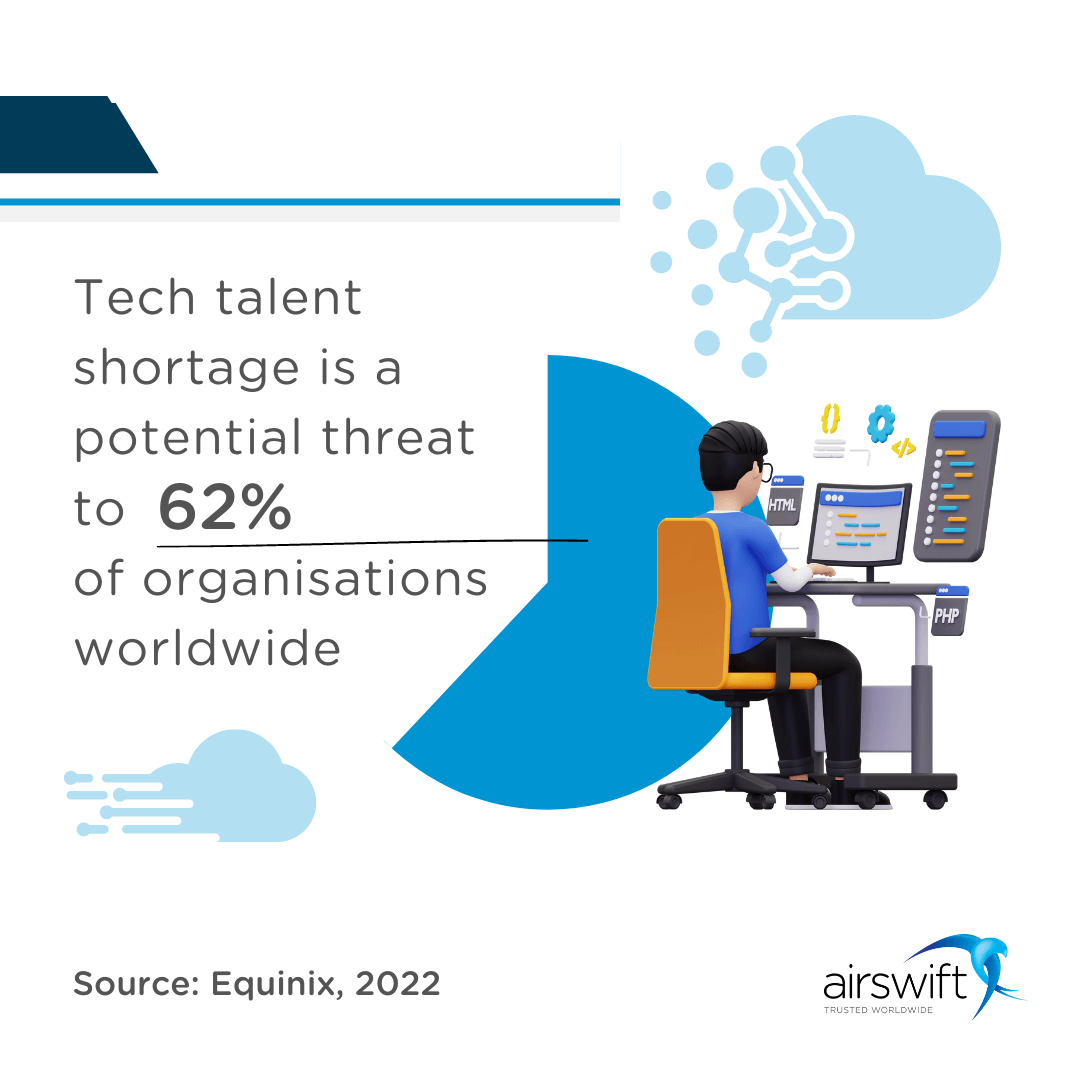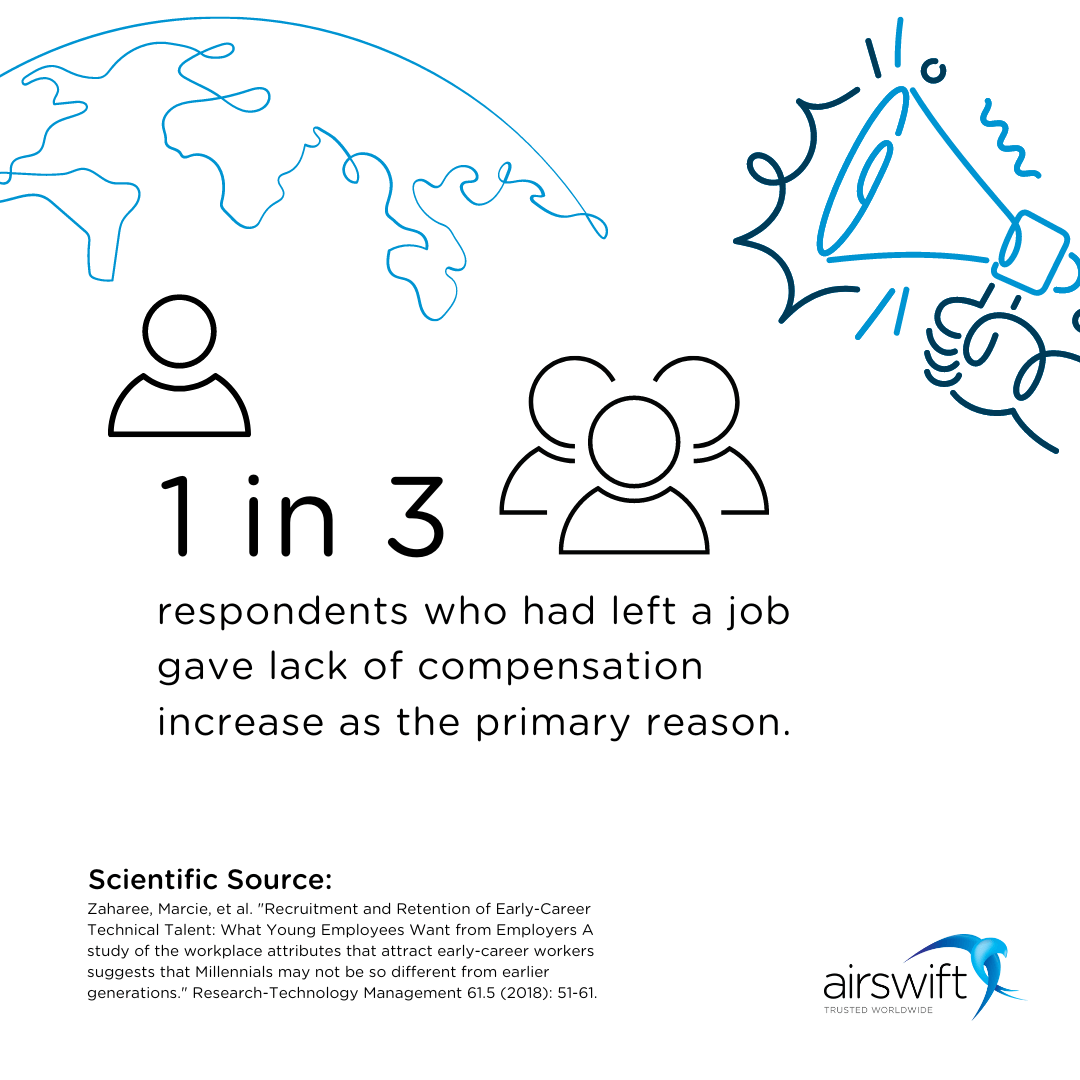
By
Raphael Santos
May 12, 2023
Updated
January 17, 2025
Competitive salaries, culture and tech clusters are crucial to retaining employees
In today's fast-paced tech industry, companies are constantly competing for top talent. But what happens when they finally hire their dream employee, only to see them leave a few months later? The tech talent retention dilemma is a pressing issue that many companies are facing.
According to Equinix's 2022 report, 62% of respondents globally identified the tech talent shortage as a potential threat to their organisations.

The reasons behind why tech employees leave their jobs are complex and varied, but there are solutions that can be implemented to address them.
In this article, we'll delve into the causes of the tech talent exodus and explore the strategies that companies can use to keep their top talent from leaving. All of that by gathering and analysing the academic answers to these questions.
Meaningful work, culture and growth are key incentives
This Research-Technology Management study (2018) explored the work-life preferences of millennials and identified workplace attributes that attract and retain young technical talent.
The study was conducted through a literature review, a survey of technical workers spanning different generations, and case studies of thriving organisations. The primary objective was to find out what implications there are for R&D organisations who are seeking to hire young technical talent.
The researchers found that there are basically six categories of incentives that millennials look for in potential employers. And these were:
- Salary and benefits.
- Professional development opportunities.
- Purposeful work.
- Flexible work arrangements.
- Organisational ethos.
Millennials and experienced employees may want the same
Taking these factors into consideration, they ran a survey to investigate the desires and requirements of entry-level technical employees. They also examined case studies of successful businesses to gather information.
The findings may surprise you: early-career technical professionals aren't so different from their older counterparts after all. That's right, there are more similarities than differences between the two groups.
Well, it turns out that all employees, regardless of their age or career stage, want the same things: a competitive salary, healthcare benefits, a robust professional development plan, flexible hours, and the option to work remotely.
This is consistent with their survey, which found that lack of compensation increase was the primary reason for one in three employees who left their jobs.

There's a twist: young workers have a desire for growth and varied experience
The biggest difference between early- and later-career professionals? The desire for quicker rotation and more continuous feedback.
Younger workers expect to stay with the same company for much of their careers, but also want a variety of experiences to support their development.
Strong leadership is vital when engaging and retaining top tech talent
But it's not just about the money. Good leadership and management are also crucial. While relationship with supervisor wasn't cited as a key factor for staying at a job, it was frequently noted as a reason for leaving.
So having a supervisor who supports professional development is key, as are transparent and engaging management practices.
Tech clusters and ESG policies are key differentiators
In a knowledge-based economy, attracting, developing, and retaining talented individuals is essential for companies to remain competitive and innovative.
Recent scientific literature suggests three novel mechanisms for recruiting technological workers: being part of a Science and Technology Park (STP), developing a Corporate Environmental Commitment (CEC), and their co-joint effect.

The first hypothesis proposed that belonging to an STP increases the likelihood of recruiting talented workers, while the second hypothesis suggested that environmental commitment increases the company's attractiveness to highly-skilled workers. The third one examined the positive moderating role of CEC on the relationship between the firm's belonging to an STP and talent recruitment.
The results indicated that variables belonging to an STP and CEC have a substitutive effect on technological talent recruitment, where corporate environmentalism and belonging to STP are two substitutive drivers of talent recruitment for Knowledge-Intensive Business Services (KIBS).
For those companies not located in a tech cluster, managers should rely on the development of corporate environmentalism, pursuing different environmental aims and practices.
Why does clustering near other tech expertise matter?
Technology-based clusters and science and technology parks are geographic areas where a concentration of tech companies, talent, and resources come together to create a dynamic ecosystem that fosters innovation and collaboration.
By being part of a tech cluster, companies have access to a pool of highly skilled and motivated tech professionals, as well as other resources like funding opportunities, networking events, and shared workspaces. This can help companies not only attract top talent, but also keep them engaged and motivated by providing a supportive and stimulating work environment.
Tech clusters also provide opportunities for collaboration and knowledge sharing between companies, which can lead to breakthroughs in innovation and the development of new technologies.
In addition, the presence of multiple tech companies within a cluster can help to create a vibrant and thriving community that attracts even more talent and investment. It's here that tech workers can enhance their career development and skills within a productive ecosystem of closely located companies.
Employee Stock Ownership Plan is not a dominant factor
The Employee Stock Ownership Plan (ESOP) can be a great way to boost employee productivity and a company's revenue. We all know the formula: a company offers its employees the opportunity to buy company shares at a specific price on or after a certain date. This is similar to the Management Stock Ownership Plan (MSOP), which focuses on company management.
ESOP has become a popular compensation program because it aligns company and employee incentives, provides a way for employees to earn money through dividends, and doesn't affect the company's cash flow.
This research from 2023 shows that ESOP implementation can reduce employee turnover intention; job satisfaction also has a big impact on turnover intention, with higher satisfaction leading to lower turnover rates.
However, the study found that the implementation of ESOP is not the biggest factor in reducing employee turnover. Instead, the biggest factor is getting job offers from other companies. Additionally, employee dissatisfaction with their salary is a major factor in turnover intention.
So, while ESOP can be a useful tool in improving employee productivity and company revenue, it's not a magic bullet for reducing employee turnover. Employers should also focus on keeping employees satisfied with their jobs and salaries to reduce turnover rates.
Remote work needs more engaging interactions
A recent study shows that employees are eager to keep working remotely even after the pandemic is over. Many respondents prefer a hybrid working environment that offers the best of both worlds. They've found that working from home has improved their work-life balance, and they want to maintain that flexibility.
But here comes the catch. While remote work has its advantages, it can also be isolating. The study found that social relationships suffer when employees work from home. This is a major challenge for organisations that want to retain talent.
To overcome this hurdle, companies need to prioritise social interactions. HR departments can play a key role in managing this issue, and social relationships should be included in remote work policies.
This is important not only for existing employees, but also for new hires who need to be integrated into the company culture.
In a remote work setting, having access to effective digital tools is crucial for improving social relationships, thus enabling more personal and engaging interactions.
No wonder these trends have led to the creation of platforms like Gather and Cosmos, designed specifically for remote work and offering immersive metaverse-style experiences.
By embracing these tools and policies, companies can continue to prioritize remote work while also fostering strong social connections among employees.
How can you retain tech talent?
So, what can R&D organisations do to attract and retain top talent? Forget the outdated assumptions about millennials and their needs, and instead focus on competitive compensation and benefits, flexible work hours, robust career development programs, and meaningful work.

All employees leave employers for similar reasons, including inadequate compensation, insufficient advancement opportunities, and poor management.
By providing continuous feedback, encouraging engagement, and ensuring transparency, R&D organisations can enhance recruitment and retention of critical early-career talent.
Good salary compensation is vital for recruitment and retention, and also being part of a tech cluster like STP can be a game-changer.
Implementing a Corporate Environmental Commitment to anticipate ESG policies may also enhance your company's appeal to talented individuals, as we observe a growing trend towards clean energy and environmental awareness in the world.
As observed, ESOPs may have a positive impact on talent retention, but they are not critical. And as remote work becomes increasingly common, finding ways to enhance social interactions is becoming a growing necessity to reduce turnover rates.
What options do you have for improving talent management?
Imagine a company that is looking to retain their top tech talent, but struggling to do so. They offer competitive salaries, but it seems that something is missing.
That's where Airswift comes in.
Airswift is a workforce solutions provider that helps companies with various aspects of employee management, from training and development to payroll and global recruitment.
Effective talent retention involves expanding your options in this situation, not just following the best practices. We can help you expand your business to emergent tech clusters.
With our global reach and expertise, we can find top tech talent in new and emerging markets, and guide them through the process of setting up operations in those locations. This not only helps your business tap into new sources of talent, but also allows you to establish a presence in growing tech hubs.
With more than 60 offices worldwide and over 9,000 contractors, we provide a comprehensive suite of workforce solutions to help you with tech talent retention while also expanding businesses to new and exciting markets.


